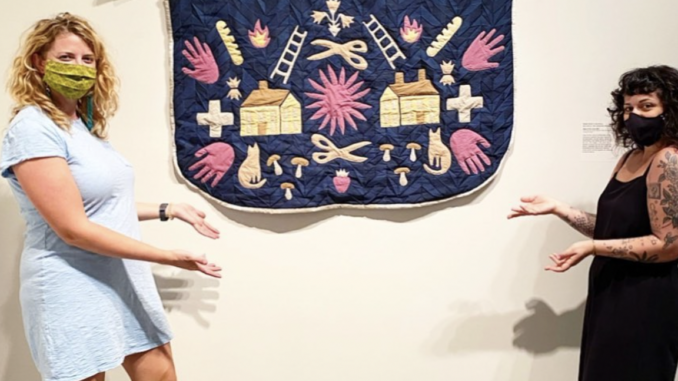
Since July 7, The Samuel Dorsky Museum has been home to the 14th annual Hudson Valley Artists exhibition, “Who Really Cares.”
With a title inspired by Marvin Gaye’s acclaimed album “What’s Going On,” the exhibit features art from twenty-eight local artists. The participating artists were asked to create work that “deals with the challenges of the past year and the re-imaginings of years to come,” according to the Dorksy website.
The exhibit is located in the Alice and Horace Chandler and North Galleries, and is being curated by Helen Toomer. It will be displayed in the museum until Nov. 14.
Julia Norton is a natural pigment and dye researcher as well as an artist. Along with her collaborator Natalie Baxter, she has created multiple pieces in “Who Really Cares.”
“It is wonderful to be included in this remarkable show,” Norton said. “I am a big fan of the curator of the exhibition, Helen Toomer, and I am honored to have this piece included in such great company.”
The exhibition features a number of different art mediums, including photography, paintings and various other forms of mixed media. According to the Dorsky website, the mere number of 28 artists were chosen from over 380 applicants.
One of Norton’s pieces featured in the exhibit, entitled “Days of Our Lives,” is a dyed quilt featuring images of scissors, hands, flames and two icons of houses in the middle. She collaborated with Baxter on the quilt.
“I am primarily a painter, working with imagery to convey memories, dreams, and moments in my life,” Norton said.
One of the main goals of “Who Really Cares” is to visually represent the past year through local artist’s work.
“It has been a year of reckoning, of questioning, of emotional and physical turmoil,” says the exhibit description on the Dorsky website. “We have been separated from, and confined with, our loved ones. This exhibition reflects a fractured year and the toll that both the minutiae and the monumental has had on us all.”
Norton has faced her own personal struggles since the start of the pandemic.
“I was finishing a year-long graduate program in Arts Education at the Harvard Graduate School of Education in March, 2020, and classes unfortunately had to go virtual,” she explained. “This was a major bummer.”
The Boston-based artist at the time moved to live with her cousins in Vermont to finish out her grad program. She was happy to be with her family but missed her community in New York City, her hometown.
“I made paintings about my deep need for human connections, and experimented with natural dyes from materials I foraged for in Vermont,” Norton said.
Norton emphasized the feelings of trauma and devastation that the personal and worldwide losses of the pandemic have caused. She also brought up the importance of connection during this time.
“COVID has affected all of us in different ways,” said Norton. “‘Care’ as a term has many meanings and ways to be manifested. Care for community, environment, each other, and ourselves is an essential part of being an empathetic human and to foster healing especially in a time when we need it more than ever. I’m happy that this exhibition exists, even to just start a spark in the minds of viewers to consider the concept of ‘care’ more in their lives.”
The Dorsky has been following a theme of exhibits being centered around community and togetherness throughout the pandemic. Just earlier this year, the “Collective Consciousness” exhibition featured work from faculty, as a way of bringing the New Paltz art department back together after a year of separation.
The feelings of isolation aren’t the only thing being focused on. Many of the other events of 2020 are brought up in different art pieces.
“The pandemic, the fight for racial justice, the trappings of domesticity, the wonder of escapism, expressions of queerness and otherness, and gratitude for art are all present here,” says the exhibit website description. “The artwork is almost all representational; you see figures, houses, people, places, things, animals and objects, striving to be present, seen, felt and heard.”
Norton hopes that these ideals and the feelings that are expressed through the art resonate with the visitors.
“Take care,” she instructed the viewers. “Practice gratitude. Consider the ways that art can communicate the kinds of feelings that are hard to express, and think of them as friends to carry with you and experience however you want to. Continue to support the artwork and the artists that make you feel something, take care of yourself, and try to think of ways to take care of those that care for you.”

